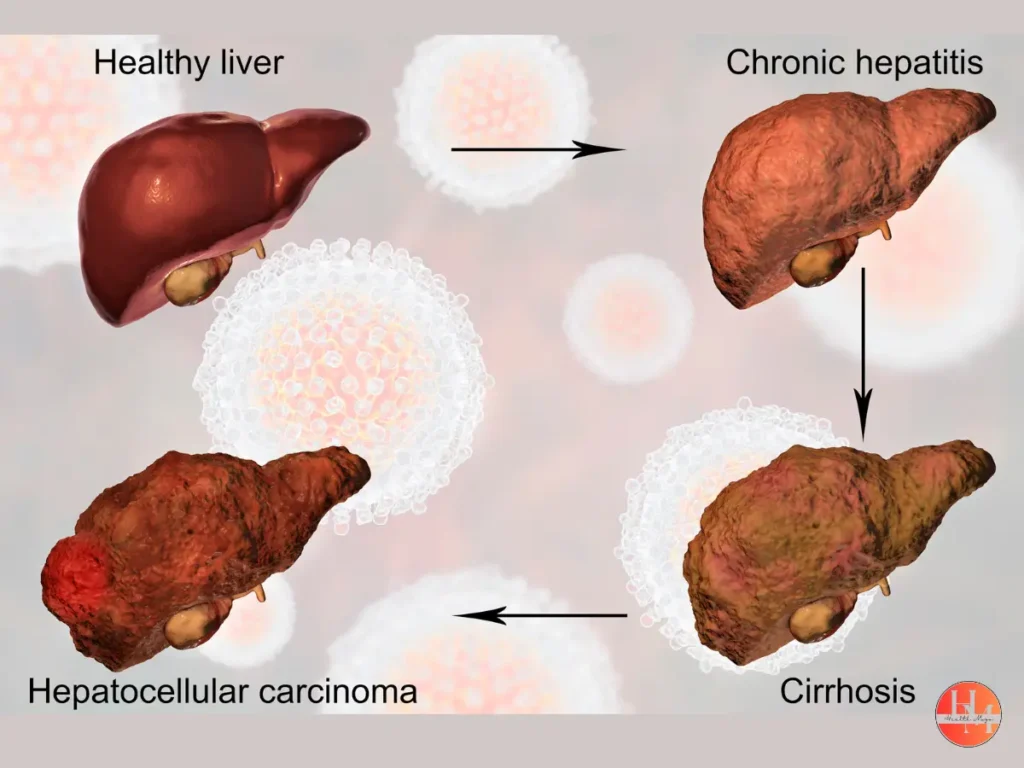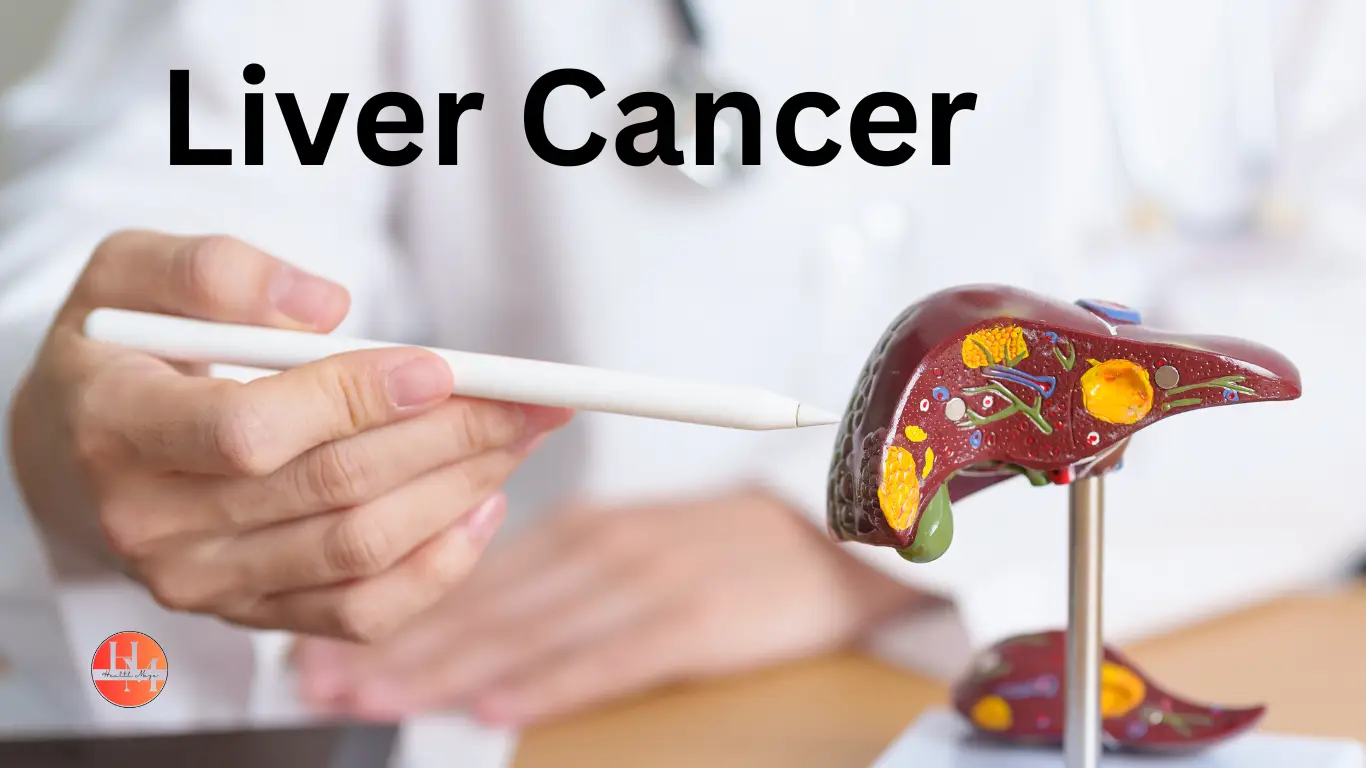Liver Cancer
Liver cancer isn’t one to mess with. It’s a serious disease that can be life-threatening. But knowledge is power, both for those battling it and their loved ones offering support. This guide dives deep into everything L. Cancer, from the symptoms and what triggers it to the treatments available and the hope that comes with improved survival rates.
Contents
What is Liver Cancer?
Definition and Basicsf
You should know that liver cancer is a type of cancer that starts in the cells of the liver, which is very dangerous for the patient.
- The liver, a vital organ responsible for numerous functions including detoxification, protein synthesis, and production of biochemicals necessary for digestion,
- It can develop malignant tumors that disrupt its (liver) operations.
Types of Liver-Cancer
There are several types of liver cancer, with the most common being hepatocellular carcinoma (HCC), which originates in the main type of liver cell. Other types include intrahepatic cholangiocarcinoma and hepatoblastoma, though these are less frequent.

Primary L. Cancer:
This starts in the liver itself. The most common types of primary L. Cancer are:
- Top Dog of L. Cancer: Hepatocellular carcinoma (HCC) takes the crown as the most common form of L. cancer.
- Hepatocyte Havoc: This nasty cancer originates in the liver’s workhorse cells, the hepatocytes.
- Cholangiocarcinoma: This cancer starts in the bile ducts, which are the tubes that carry bile from the liver to the small intestine.
- Hepatoblastoma: This is a rare type of L. cancer that usually occurs in children.
- Angiosarcoma: This is a very rare type of L. cancer that starts in the blood vessels of the liver.
Secondary L. Cancer:
This cancer starts somewhere else in the body and then spreads to the liver. The most common cancers that spread to the liver are colorectal cancer, breast cancer, and lung cancer.
Liver Cancer Symptoms
Common Symptoms
L. cancer often doesn’t cause symptoms in its early stages. When symptoms do appear, they might include weight loss, loss of appetite, upper abdominal pain, nausea, and vomiting.
- Unintentional weight loss
- Loss of appetite
- Pain in the upper right abdomen or right shoulder blade
- Feeling tired and lacking energy
- Nausea and vomiting
- Swelling or bloating in the abdomen
- Yellowing of the skin and whites of the eyes (jaundice)
- Dark-colored urine
- Pale stools
Early vs. Advanced Symptoms
In early stages, symptoms are typically mild and can be mistaken for other conditions. Advanced liver cancer symptoms are more severe and may include jaundice (yellowing of the skin and eyes), swelling in the abdomen, and pain in the right shoulder.
Causes of Liver Cancer
Primary Causes
L. can be caused by chronic infection with hepatitis B or C viruses, cirrhosis, certain inherited liver diseases, diabetes, and nonalcoholic fatty liver disease.
- Chronic viral hepatitis: Infections from hepatitis B or C viruses can damage the liver and raise cancer risk.
- Cirrhosis: This scarring condition, often caused by heavy alcohol use or chronic hepatitis, increases cancer risk.
- Nonalcoholic fatty liver disease (NAFLD): This buildup of fat in the liver can progress to cirrhosis and potentially cancer.
- Heavy alcohol consumption: Damages liver cells and increases risk of cirrhosis and cancer.
- Certain genetic disorders: Hemochromatosis (iron overload), Wilson disease (copper buildup), and alpha-1 antitrypsin deficiency can raise risk.
- Type 2 diabetes: May increase risk, though the exact link is still being studied.
- Exposure to aflatoxins: Toxins produced by mold on grains like peanuts can be a risk factor, especially in high-exposure situations.
Risk Factors
Risk factors include heavy alcohol use, obesity, diabetes, and exposure to aflatoxins (toxins produced by molds that grow on crops stored in warm, damp conditions).
- Chronic viral hepatitis B or C infection: These viruses damage the liver over time, increasing cancer risk.
- Cirrhosis: This scarring condition, often caused by hepatitis or alcohol abuse, creates a fertile ground for cancer.
- Nonalcoholic fatty liver disease (NAFLD): Fat buildup in the liver, linked to obesity and diabetes, can progress to cirrhosis and cancer.
- Heavy alcohol consumption: Damages liver cells and significantly raises the risk of both cirrhosis and cancer.
- Certain genetic disorders: Hemochromatosis, Wilson disease, and alpha-1 antitrypsin deficiency can increase cancer risk.
- Type 2 diabetes: May be a risk factor, though the exact connection is still being researched.
- Exposure to aflatoxins: These toxins from mold on grains can be a risk, particularly in areas with high exposure.
Liver Cancer Survival Rate
General Statistics
The survival rate for L. cancer varies widely depending on the stage at diagnosis. According to recent data, the 5-year relative survival rate for localized L. cancer is around 31%.
Factors Influencing Survival Rate
Survival rates are influenced by the cancer stage at diagnosis, overall health, response to treatment, and liver function.
Symptoms of Liver Cancer
Digestive Symptoms
- Digestive Distress: Nausea, vomiting, and a disappearing appetite can strike, making it tough to keep any food down.
- Shrinking Silhouette: These unpleasant symptoms can lead to weight loss you didn’t ask for.
Systemic Symptoms
Other symptoms might include general weakness, fatigue, and fever.
Stages of Liver Cancer
Liver cancer is staged using two main systems: the TNM system and the BCLC system.
TNM System: This common cancer staging system focuses on the size (T) of the tumor(s), lymph node involvement (N), and distant metastasis (spread, M).
- Stage 1: Early stage with a single, small tumor confined to the liver (T1, N0, M0).
- Stage 2: More advanced than stage 1, with either a larger single tumor or multiple smaller tumors, but still confined to the liver (T2, N0, M0).
- Stage 3: Further progression, with either larger tumors or spread to major blood vessels within the liver (T3, N0, M0).
- Stage 4: The most advanced stage, where cancer has spread beyond the liver to distant organs (T any, N any, M1).
BCLC System: This system considers both the stage of the cancer and the overall liver function.
- Stage 0 (Very Early): A single small tumor with normal liver function.
- Stage A (Early): Early stage tumors with normal or slightly abnormal liver function.
- Stage B (Intermediate): One large tumor or multiple smaller tumors, but the liver is functioning reasonably well.
- Stage C (Advanced): Cancer has spread to nearby blood vessels or other organs, but liver function is still relatively good.
- Stage D (End Stage): Advanced cancer with poor liver function or spread to distant organs.
Key Points:
- Lower stages generally indicate a better prognosis.
- The BCLC system also considers liver function, impacting treatment options.
- A doctor can explain your specific stage and its implications for treatment and prognosis.
Diagnosis of Liver Cancer
Medical History and Physical Exam
Doctors begin with a thorough medical history and physical exam to identify risk factors and symptoms.
Also, read the Liver Function Test LFT
Imaging Tests
Imaging tests like ultrasound, CT scans, and MRIs help visualize the liver and identify abnormalities.
Biopsy
A liver biopsy involves removing a small sample of liver tissue for examination under a microscope to confirm the diagnosis.
Liver Cancer Treatment Options
Surgical Treatments
Surgical Strike: For early-stage liver cancer, surgery becomes a weapon of choice. This can involve removing part of the liver (liver resection) or replacing the whole liver with a healthy one (liver transplant).
Non-surgical Treatments
For advanced liver cancer, non-surgical treatments like chemotherapy, radiation therapy, targeted therapy, and immunotherapy may be used.
Surgical Treatments for Liver Cancer
Liver Resection
Liver resection involves removing the part of the liver affected by cancer. It’s typically done when the tumor is small and confined to a portion of the liver.
Liver Transplant
- Trading Up Your Liver: A liver transplant becomes a lifesaving option when cancer is restricted to the liver, but surgery to remove part of the liver (liver resection) isn’t possible.
- This major procedure involves replacing the entire diseased liver with a healthy one donated by a deceased or living donor.
Non-Surgical Treatments for Liver Cancer
- Chemical Warfare (Chemotherapy): This treatment deploys powerful drugs to directly target and eliminate cancer cells or halt their growth. These drugs can be taken by mouth or delivered through an IV.
- Zapping the Enemy (Radiation Therapy): High-energy rays become the weapon of choice in radiation therapy, aiming to fry cancer cells. This treatment often steps in when surgery isn’t an option.
- Smart Bombs (Targeted Therapy): These specialized drugs act like smart bombs, seeking out and attacking cancer cells with minimal harm to healthy cells. They work by disrupting specific molecules involved in tumor growth, essentially cutting off the cancer’s fuel supply.
- Supercharging Your Defenses (Immunotherapy): This approach unleashes the body’s natural defenses to take on cancer. It utilizes substances, either made by the body or created in a lab, to rev up or restore the immune system’s ability to fight the disease.
Living with Liver Cancer
Managing Symptoms
Managing symptoms involves medication, lifestyle changes, and sometimes, integrative therapies like acupuncture or massage.
Emotional and Psychological Support
Support groups, counseling, and therapy can help patients and their families cope with the emotional and psychological impact of L. Cancer.
Preventing Liver Cancer
Lifestyle Changes
Preventing liver cancer involves maintaining a healthy weight, avoiding excessive alcohol consumption, and not smoking.
Regular Screenings
Regular screenings for liver disease, particularly for those at high risk, can help detect liver cancer early.
Recent Advances in Liver Cancer Research
New Treatments
Recent advances include new drug therapies, improved surgical techniques, and better imaging methods to detect and treat liver cancer early.
Ongoing Research
Ongoing research is focused on understanding the genetic and molecular basis of liver cancer to develop more effective treatments.
Conclusion
- L. cancer: A Complex Foe: Don’t be fooled by the name – L. cancer presents a multifaceted challenge. To combat this enemy, a multi-pronged approach is needed, combining diagnosis techniques with a range of treatment options. The good news? Early detection and continuous advancements in treatment are giving patients a fighting chance, with improved survival rates.
Here’s the key to staying ahead of the game: Regular check-ups to monitor your health and embracing a healthy lifestyle can be powerful preventive measures.
FAQs
What is the first sign of liver cancer?
The first sign is often weight loss and loss of appetite, but it can vary among individuals.
Can liver cancer be cured?
If detected early, L. cancer can often be treated effectively, sometimes even cured. Advanced stages are more challenging but treatments are improving.
How is liver cancer diagnosed?
Diagnosis typically involves a combination of medical history, physical exams, imaging tests, and biopsies.
What are the main risk factors for liver cancer?
Chronic hepatitis B or C infection, cirrhosis, heavy alcohol use, obesity, and exposure to aflatoxins are major risk factors.
What advancements are being made in liver cancer treatment?
Advancements include new targeted therapies, immunotherapies, and improved surgical techniques.


5 thoughts on “Decoding Liver Cancer: From Symptoms to Survival Strategies”